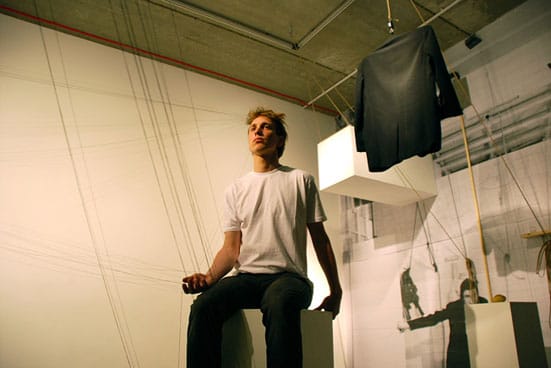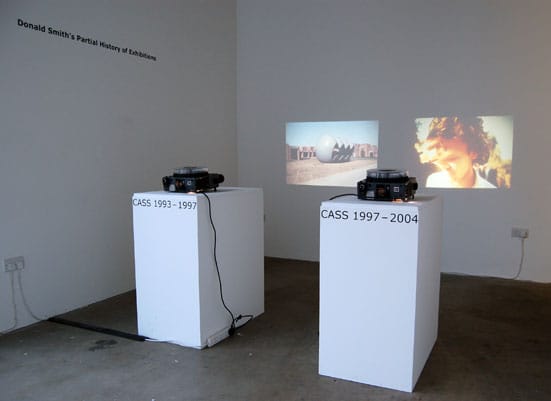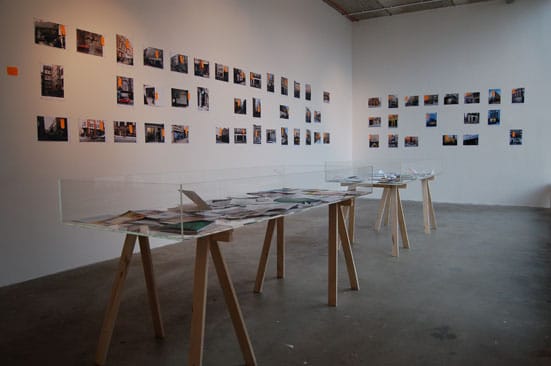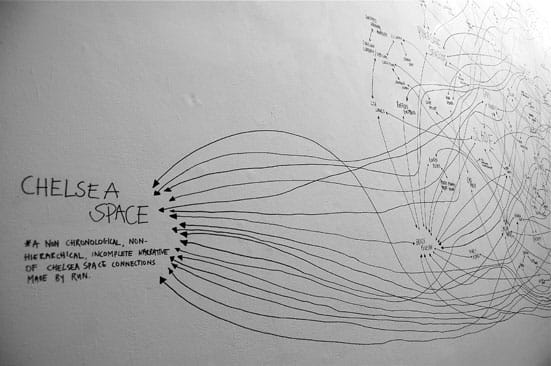Jesse Benson and Becky Koblick interview RUN on the exhibition Should I Stay or Should I Go? – A question rehearsed by RUN, at CHELSEA space, London, until 17 April 2010
1. Can you give us a little background on RUN and your relationship with Chelsea Space? How did you come to be invited by Donald Smith to curate such an important exhibition marking the five year anniversary of the gallery?
RUN was founded in 2006 as a peripatetic project space in Berlin by Hana Noorali and Rebecca Ribichini, with Lynton Talbot joining shortly after. RUN's affiliation with Chelsea Space started when we were students at Chelsea College of Art. At the time, it was important for us to have such a space on our doorstep. We were able to see as well as work on a wide range of multidisciplinary exhibitions with international artists. Rebecca and Hana documented the first couple of shows and Lynton worked full time at Chelsea Space over three months. Rebecca is no longer part of RUN, but Elena Crippa joined at the beginning of 2009: we all met at the Lisson Gallery, where we worked on a number of shows together. RUN would frequently assist in the installation of exhibitions at Chelsea Space and, in 2007, we invited Donald to curate the RUN summer exhibition. He organised a great group show, titled 3things. Working so closely with Donald, it became apparent that we share a similar interest in collaborations and value the importance of addressing the wider cultural landscape through exhibition making. It was essentially this connection that led to the invitation to organise the 5th year anniversary exhibition. Our strong personal relationship with Donald and RUN's understanding of the attitude and nature of the way in which Chelsea Space operates means that we have an in depth knowledge of the gallery and care for its programme.
2. Through the example of Chelsea Space, this performative exhibition project embarks on a larger conversation about the activity and ephemera surrounding an exhibition. The installations and happenings within the 5 acts function to amalgamate the moment of exhibition with the archive, the rehearsal, and the social surroundings. The effect is the production of new contexts and projects, rather than a retrospective-type nostalgic or narrative documentation. Were the artists and curators chosen to participate based on their ability to operate within this discussion of active ephemera, or were invitations based more on the nature of their previous interactions with Chelsea Space?
The non-nostalgic take on histories and archives is one of the aspects that we had found the most compelling looking back at many of the exhibitions organised at Chelsea Space. With our project we certainly wanted to convey such active and overtly personal ways of relating to materials and histories. We also wanted to avoid or at least address certain conventions that dominate the way in which material is selected, labeled and presented. We are certainly not keen on conventionally accepted aesthetics that, independently from the objects or materials displayed, always seem to privilege formal, systemic, hierarchical and inert presentations. This is maybe the way in which we would like to understand your definition of our exhibition as ‘performative': in the tradition set by Chelsea Space, we were aiming for the dialogues and processes involved in the making of the exhibition to be as visible and transparent as possible. We chose particular artists and curators to collaborate on the project for two major reasons. On one side, we wanted to include individuals who have been playing an important role in shaping the programme of Chelsea Space through encounters, conversations and active involvement over the years. On the other side, we were indeed particularly drawn towards certain individuals because of their way of working (which we understand as being process-based), and because of their interest in collective endeavours. We could define the attitude shared by many of the artists and curators we invited as a highly personal and passion-driven capacity for activating materials, objects or documents as well as engaging in collaborative projects.
3. Does the 5-act structure of this exhibition reflect the 5-year history of Chelsea Space – 5 acts for 5 years? How has this model pushed the overall exhibition concept? How might things have been different if, say, a month was devoted to each act rather than a week? Would that disallow the read of a singular exhibition viewed in parts?
The 5-act structure does not reference the 5-year history of Chelsea Space, but seemed a natural way to divide the allocated time. Going back to the previous question, having established that we did not want a static, object orientated retrospective of Chelsea Space, we felt it necessary to offer appropriate space and time to key individuals to each present an aspect of this history. Thinking about projects and ideas and stories and micro-histories that people have brought to Chelsea Space over the five-year period, we felt it important to introduce these key people again, in order to centre new activity around their involvement and relationship with Donald and the gallery. It was crucial for us to view this project as a definite and single exhibition divided into 'acts'. If for example, as you suggested, we could have realised these acts over five months, we would have looked at a very different set of exhibitions. It was important that not only the individual acts were realised with independent integrity but also that the five weeks felt like an exhibition in its own right and an exhibition that celebrated Chelsea Space's five-year history. We conceived of a number of strategies to bind this fluctuating and precarious activity together as a whole. We wanted to acknowledge and celebrate not only the archive and relationships but also explicitly highlight the way in which Chelsea space 'works'. Socially, architecturally and intellectually. These things are key in understanding its history. For example, the navigation of the show is important. You enter and see images of archive material, you move on and read the diagram of relationships we drew on the wall. Last, you enter the main gallery, with one glass wall onto the outside world and a new and evolving exhibition taking place week by week. This is the space dedicated to the opening up of conversations and ideas, with a sense that the new activities are building upon an existing archive and looking as much to the future as to the past. The conversations and dialogues between ourselves, Donald and the invited 'curators' when negotiating these one-week pursuits, were in many ways as important as the work itself. In the very ethos of Chelsea space, we attempted to translate as much as possible these debates into the variety of the programme and nature of the displays.
4. If this project is more-or-less about the archive, how will Should I Stay or Should I Go? be represented in Chelsea Space's archive, and in a related question, how do you imagine the project potentially affecting future archiving processes at Chelsea Space or elsewhere?
We can imagine that a few of the elements presented in the gallery, much correspondence and many other random objects will enter Chelsea Space archive, but this is down to director Donald Smith. If we had to hope for our show to have a role in a future discourse on the way histories are archived, it would be in relation to the attempt to document human relationships as important agents, over and above individual authorial statements (this is without doubt in clear opposition with the way in which most curatorial projects are commonly presented and read). Our approach to archives, similarly to the approach of many of the individuals who have organised shows at Chelsea Space over the years, is indeed reflected in the diagram of relationships we have drawn on one of the gallery walls. If in Alfred H. Barr's notorious diagram (which was one of our references) arrows represent sort of causal claims in relation to the degree, extension and direction of influences, in our graph arrows aim to represent the propagation of energy intrinsic to any dialogue or meeting. We hope for our circular arrows to exemplify fluid and non-hierarchical relationships of reciprocal exchange and collaboration.
Reading through the list of people who, in different ways, have contributed to Should I Stay or Should I Go?, one can realise what an incredible collective effort it has been. We would like to take the opportunity to finish this interview by mentioning them all. A warm thank you to: Hessa Al Bader, Will Alsop, James Balmforth, Mark Barker, David Barnett, Luma Bashmi, Oleg Bilenchuk, Sam Belinfante, boyleANDshaw, Patrick Coyle, Alicia De Toro, Ali Epps, Teresa Gleadowe, David Gothard, Evangelos Gerogiannis, Gustavo Grandal Montero, Will Huntley, Mike Iverson, Daeun Jeong, Mick Jones, Nataasha Van Kampen, Lisa Le Feuvre, Neil Luck, Dominic McGlynn, Bruce McLean, Jo Melvin, Edwin Morris, Lynda Morris, Gyeyeon Park, Clive Phillpot, Maya Ramsay, Tim Rowson, Amanda Samon, Syd Shelton, Robert Sherwood, Frank Sidebottom, Cally Spooner, Dean Tatulli, Edward Thomasson, Mark Titchner, Suzanne Triester, Richard Wentworth and Gary Woodley.
Jesse Benson, Becky Koblick and RUN Gallery

Bruce McLean, Should I Go (High Up...) featuring Nice Style, 2010 installation, with bar by Lynton Talbot and Tim Rowson and bench by Gary Woodley

JocJonJosch staging a performance investigating their relationship as a group of three, 15th March 2010

Installation view of 'Donald Smith's Partial History of Exhibitions: 1993 – 2010', a display by Lisa Le Feuvre

Teresa Gleadowe with Richard Wentworth: a partial mapping of London art venues present and past

An incomplete narrative of CHELSEA space connections made by RUN (detail)